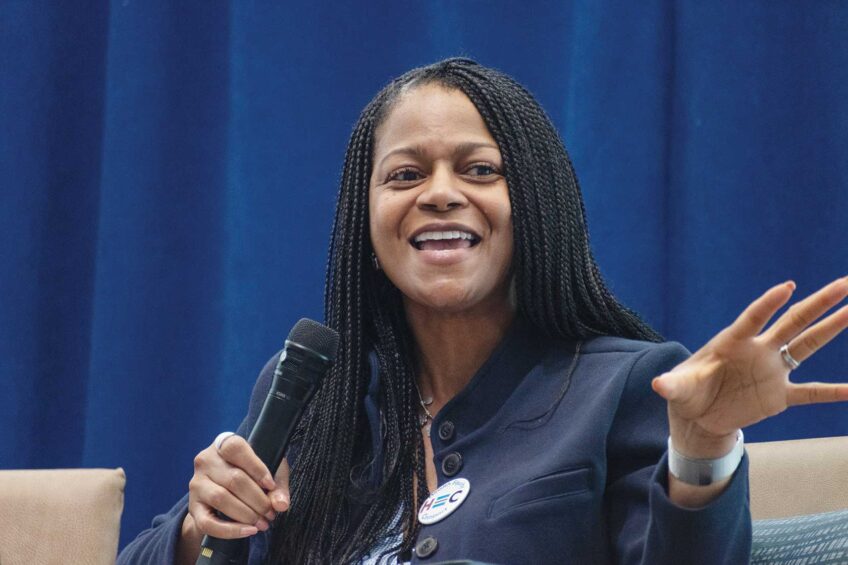ELIZABETHTOWN, Pa. — Richmond Sutton mumbles. Other times, he freezes and simply stops talking, pregnant pauses that halt the conversation.
Parkinson’s disease is stealing little bits of Sutton, carving away at the speech and mobility of this gentle, dignified man in the light blue sweater who is sitting in a wheelchair.
But then the 89-year-old, an Episcopalian who grew up singing in church choirs, launches without hesitation into the opening bars of the hymn “Amazing Grace.”
For a moment, his tenor voice is strong and clear.
Later, he pushes himself up from his wheelchair. He is stooped and shaky and needs support to get on his feet.
But then he dances. Oh, how he dances.
He moves his feet slowly to the waltz tempo of “The Band Played On,” and his mouth opens into a broad circle as he sings along about the girl with the strawberry curls during a music program for residents of the Health Care Center at the Masonic Village in Elizabethtown.
Music animates Sutton in a way that is drawing increasing attention from researchers studying its effects on some of the estimated 1 million people with Parkinson’s in this country.
Music is being used as therapy for people with Parkinson’s disease in St. Louis, Chicago, Charlottesville, Va., and Elizabethtown.
Parkinson’s disease is a chronic, progressive movement disorder caused when a group of cells in a certain part of the brain begin to malfunction and die, according to the National Parkinson’s Foundation.
People with Parkinson’s typically have symptoms that include tremors, rigidity, slowness of movement and impaired balance.
There is no cure for Parkinson’s, but patients benefit from medication and therapy, including music therapy.
With its rhythm and structure, music can spark coordinated movement in people with Parkinson’s, says Ann Dinsmore, a music therapist at Masonic Village.
“Music triggers the brain,” Dinsmore says, “and there is an automatic response. It’s like when you hear singing and don’t realize you are tapping your foot.”
It has helped Sutton in a variety of ways. Sometimes, he would physically “freeze” while walking back to his room after a meal, and he would be unable to move, a vexing problem for those with Parkinson’s.
Jennifer Hinton, a musical therapist, would start to sing “Show Me the Way to Go Home” and the music would help him to start moving again.
Also, when Sutton is engaged with music, his tremors lessen.
“Music organizes movement,” Dinsmore says.
Music helps others at Masonic Village as well. People with dementia who have forgotten simple tasks such as how to zip a zipper or button a button often can remember and sing songs from their youth.
“People who can’t get up from the chair can remember how to foxtrot or waltz,” she says. “Some people can’t speak, but they can sing.”
Music improves mood, circulation, organization of thoughts and coordination, Dinsmore says.
Research confirms this.
A study at the Washington University School of Medicine in St. Louis showed that people with Parkinson’s disease who took regular tango lessons had significant improvements in balance and mobility, compared with those who did conventional exercise.
In Chicago, Rush University Medical Center is collaborating with a dance company in a contemporary dance program for people with Parkinson’s. The idea is that moving to music will reinforce movement pathways in the brain, or create new ones, as well as fight the depression often felt by Parkinson’s patients.
And a study is under way at the Methodist Neurological Institute in Texas to determine which musical rhythms are more therapeutic for Parkinson’s patients. Ultimately, the goal is to create a device, similar to a personal music device, tailored to a patient’s particular needs.
In his 2007 book, “Musicophilia,” Oliver Sacks has a chapter on Parkinson’s disease and music therapy. The professor, author of the book “Awakenings” that was made into a 1990 film, describes how music lights up and awakens people with Parkinson’s.
Music is what they need, he writes, “for only music, which is rigorous yet spacious, sinuous and alive, can evoke responses that are equally so.”
Just ask Bob Dawson, a Canadian man with Parkinson’s who writes a blog called “Parkinson’s Patients: Yes We Can Dance.”
He writes: “A friend bombarded me with the blues. I started to dance, and groove, and visualize. Music on disease much better. Music off symptoms come back. How come?
“This site does not contain a cure for Parkinson’s. I do not know if music and dance can help everybody.
“If you have Parkinson’s, it is my personal, nonscientific opinion that you should find music that you get off on, play it loud, and start to move to the music. Every day.”
Masonic Village offers dances every three months in its Health Care Center. Usually about 100 people attend.
The story is told in their faces, which light up with joy as they sing and tap their feet. Those who are able waltz around the floor. Workers push others in their wheelchairs. Years melt away as they sing, “In the shade of the old apple tree, where the love in your eyes I could see …”
Sutton says that when the music comes on, he can move more easily.
He feels freer, too.
“I’m not inhibited in any way,” he says.
“I feel it’s just something that comes out of me.”
(The Lancaster, Pa., New Era)






